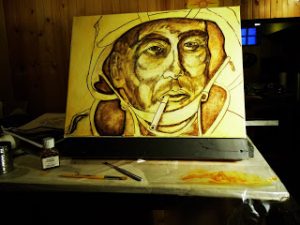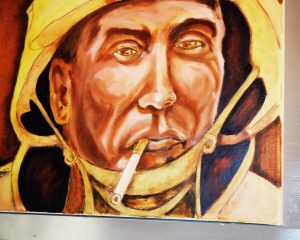
After completing a rough sketch, the canvas was toned with a
transparent yellow ochre mixed with a medium and turpentine.
It doesn’t matter whether you are painting on canvas, a metal panel, Masonite, wood or MDO. If your substrate is white, the stark brilliance of the surface can be overpowering and distracting. For this reason artists have toned their painting surfaces for centuries.
Typically, a canvas or another substrate was toned with a wash of an earth tone colored paint. Oil paint thinned with a high percentage solvent, such as turpentine, is brushed on the surface or applied with a cloth. When you have finished toning the surface with the transparent layer of paint, it will look as if you have applied a stain to it. This coating is sometimes referred to as the “imprimatura” or the first color layer.
By toning the surface with a neutral color, if an application of paint does not completely fill in the texture of the canvas, flecks of the uncovered base white will not be quite so noticeable. More importantly, a coating of thinned paint applied to the surface will protect your underlying drawing on the surface.
Many artists today will tone the background with an earth tone color. The color or mixture of colors that you use is a personal preference. The list of colors that are frequently used for toning include: Raw Sienna, Burnt Sienna, Red Iron Oxide, Ochre, Raw Umber and Burnt Umber. But some of the old Dutch masters used a more complex mixture. After mixing lead white and carbon black to produce a grey tone, they added earth tone pigments to warm up their mixture.
Artists have developed all types of concoctions for toning the canvas. Whatever mixture you use, toning the surface can visually unify the background and create the mood of the painting. The warmth of an earth tone wash can also warm up any subsequent applications of paint.

After toning the canvas, you can start to build the values.
For toning a canvas, try the following toning mixture:
- Create a thinning solution of 50% artist’s turpentine and 50% medium, such as Liquin Original Oil Medium (Winsor & Newton) or Walnut Alkyd Medium (M. Graham & Co.).
- Thin the paint that your choose for toning in the proportions of 2/3 thinning solution to 1/3 paint.
- Brush the toning mixture over the entire surface of the painting including the sides of the canvas.
- After waiting a few minutes, wipe off the excess toning mixture with a clean, lint-free rag so that the painting surface is a uniform color.
- If the toning mixture is not coming off the painting in the way that you like, wet your rag with turpentine and rub over the troublesome areas.
- Let the toning mixture dry completely before continuing to paint.
Remember that the mixture and procedure that I just described is just one of many ways to tone a canvas. My suggestion is to try different techniques. That way you will ultimately settle on those methods that suit your requirements.


